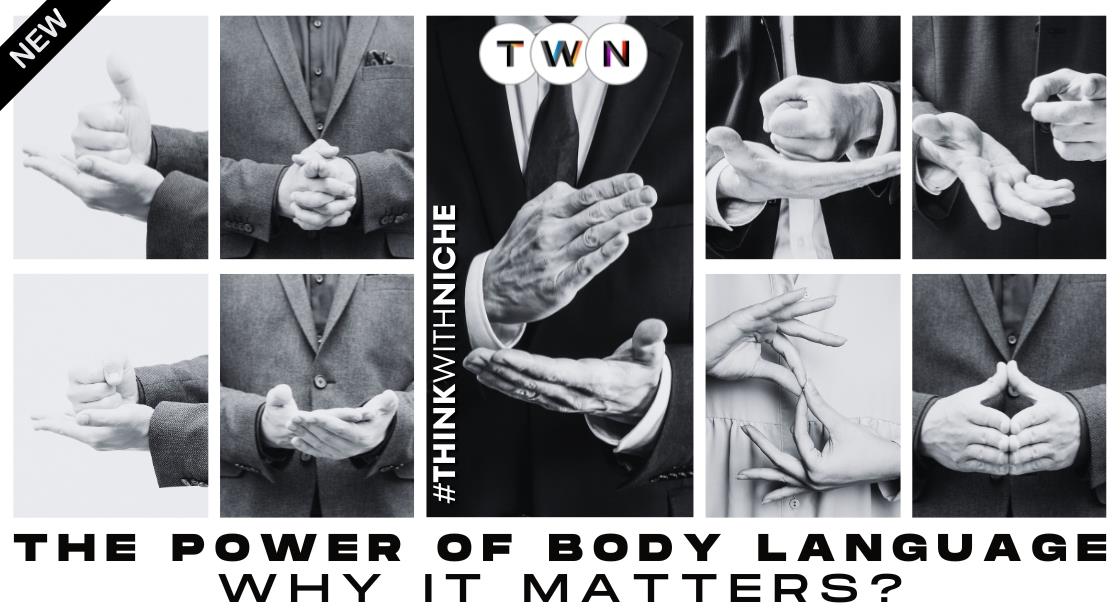The Power of Body Language: Why it Matters More Than You Think

Blog Post
Communication is more than just words; it's a symphony of nonverbal cues that carry profound significance in our daily interactions. Beyond the spoken language, the unspoken cues of body language—gestures, expressions, and postures—hold a remarkable influence.
Studies reveal that a significant portion of our communication, sometimes over 50%, relies on these silent signals.
Welcome to an exploration of the silent language that speaks volumes: body language. In a world where conversations extend beyond verbal exchanges, understanding the nuances of body language emerges as a pivotal skill.
This blog delves into the intricate realm of nonverbal communication, unraveling its importance, nuances, and impact in both personal and professional spheres.
Join us on a journey to decipher the unspoken language that shapes our interactions, relationships, and success.
Let's unravel the secrets behind facial expressions, gestures, eye contact, and postures, decoding the silent cues that define our everyday communication."
This introduction sets the stage for a detailed exploration of body language, highlighting its significance in communication and the forthcoming insights into its various facets and applications.
In today's world, effective communication extends beyond just spoken words. The unspoken language of gestures, facial expressions, and posture significantly impacts our daily interactions.
Body language is a silent yet incredibly powerful form of communication. While verbal communication is essential, understanding and mastering the art of interpreting nonverbal cues—expressed through gestures, facial expressions, postures, and tone—can elevate our interactions to new levels of understanding and connection.
The intricate dance of body language impacts our daily lives, shaping how we perceive and respond to others and how others perceive and respond to us.
Research has shown that a substantial percentage of our communication—often more than 50%—relies on nonverbal cues. The power of body language lies in its ability to convey emotions, thoughts, and intentions without uttering a single word.
What is Body Language?
Body language serves as a silent form of communication
Body language is a form of non-verbal communication that uses physical behaviors, expressions, and mannerisms to convey information and emotions. It's a powerful way to communicate our thoughts, feelings, and intentions without saying a single word.
Every movement we make, from our facial expressions to the way we stand and walk, sends out a message. By understanding the meaning of these nonverbal cues, we can gain valuable insights into people's thoughts and feelings, improve our communication, and build stronger relationships.
Key elements of body language:
Let's delve deeper into the key elements of body language and explore how each aspect contributes to communication and interpersonal dynamics:
1. Facial Expressions:
Facial expressions are a primary means of conveying emotions and intentions. They offer a window into an individual's feelings, often communicating more than words. For instance:
-
Happiness: An authentic smile accompanied by lifted cheeks and wrinkles around the eyes.
-
Sadness: Drooping corners of the mouth, furrowed brows, and teary eyes.
-
Anger: Furrowed brows, narrowed eyes, and tightened lips.
-
Surprise: Eyes widened, eyebrows lifted, and mouth agape in an open expression.
-
Fear: Eyes widened, eyebrows raised and drawn together, mouth slightly open.
Recognizing these cues aids in understanding others' emotional states. For instance, during a conversation, noticing a friend's frown can prompt a query about their feelings, fostering empathetic communication.
2. Posture and Body Orientation:
How we carry ourselves communicates volumes about our confidence and openness:
-
Confidence: Standing tall, shoulders back, and an open posture indicate confidence and assertiveness.
-
Insecurity: Slouched shoulders, crossed arms, or hunched posture might signify insecurity or discomfort.
Imagine a job interview scenario where a candidate sits upright, maintaining eye contact and an open posture, projecting confidence and competence, contrasting with another candidate who appears closed-off and nervous.
3. Gestures:
Hand and arm movements complement verbal communication:
-
Open Gestures: Palms facing up while speaking, expansive arm movements, or open-handed gestures often denote openness, honesty, and enthusiasm.
-
Closed Gestures: Crossed arms, clenched fists, or finger-pointing might indicate defensiveness, disagreement, or discomfort.
During a negotiation, using open-handed gestures can convey trustworthiness, fostering a positive environment conducive to collaboration.
4. Eye Contact:
Eye contact is a fundamental aspect of communication:
-
Sincerity and Interest: Maintaining direct eye contact demonstrates engagement, sincerity, and active listening.
-
Disinterest or Nervousness: Avoiding eye contact might signal discomfort, disinterest, or even dishonesty.
In social settings, making appropriate eye contact during conversations shows respect and indicates attentiveness.
5. Touch:
Touch communicates various emotions and intentions:
-
Support and Warmth: A gentle touch on the arm or shoulder can convey empathy, support, or reassurance.
-
Aggression or Threat: Forceful or invasive touch might evoke discomfort or fear.
Consider how a comforting pat on the back or a handshake can strengthen camaraderie during a team meeting or a congratulatory moment.
Understanding and interpreting these nonverbal cues enriches our interactions, fostering effective communication and stronger connections.
Also Read: Discover Your Direction and Meaning in Life: Embrace Change
Importance of Body Language:
Body language plays a crucial role in communication. In fact, some studies suggest that as much as 93% of communication can be attributed to nonverbal cues. This means that even when we think we're just expressing ourselves through words, our body language is often saying something entirely different.
Understanding body language can help us in several ways:
Harnessing the Power of Body Language: Benefits and Practical Examples
Understanding the intricacies of body language can be transformative, unlocking a deeper understanding of human interaction and empowering you to achieve greater success in various aspects of life. Let's delve into the specific benefits and explore practical examples that illustrate the power of this silent language:
1. Enhanced Communication and Reduced Misunderstandings:
Imagine a job interview. You deliver a well-prepared response, but your crossed arms and averted gaze communicate nervousness and disinterest. This mismatch between verbal and nonverbal cues can create confusion and detract from your message.
Conversely, maintaining eye contact, nodding thoughtfully, and mirroring the interviewer's open posture can project genuine interest and confidence, enhancing your communication and creating a positive impression.
2. Building Stronger Relationships and Fostering Trust:
A warm smile, a friendly pat on the shoulder, and an open, relaxed posture convey warmth, approachability, and genuine interest in others. These nonverbal cues pave the way for building strong relationships based on trust and mutual understanding.
In a team setting, leaning in during conversations, actively listening, and maintaining eye contact can demonstrate respect and encourage open communication, fostering a more collaborative and cohesive environment.
3. Boosting Confidence and Self-Presentation:
Walking tall, maintaining good posture, and making direct eye contact are all nonverbal signals of confidence and self-assuredness. By consciously practicing these positive body language cues, you can not only appear more confident to others but also feel more confident yourself. This newfound confidence can help you overcome challenges, assert your opinions, and navigate difficult situations with greater ease.
4. Increasing Influence and Persuasive Power:
Leaders who utilize confident body language, such as standing tall with open arms and using firm but controlled gestures, naturally project authority and inspire trust in their followers.
Similarly, in sales presentations, using open palms, nodding enthusiastically, and mirroring the customer's gestures can build rapport and encourage them to be receptive to your message.
Examples in Action:
-
In a job interview: When asked about your strengths, lean in slightly, smile confidently, and make direct eye contact while emphasizing your relevant skills and experiences. This nonverbal communication reinforces your verbal message and projects a strong, competent image.
-
During a difficult conversation: If a friend is upset with you, maintain open body language, avoid crossing your arms, and make eye contact to show that you are receptive to their feelings and open to a constructive conversation.
-
When giving a presentation: Use clear and concise gestures, avoid fidgeting, and project your voice confidently. These nonverbal cues will keep your audience engaged and ensure your message is delivered effectively.
By actively understanding and employing the power of body language, you can significantly enhance your communication, build stronger relationships, boost your confidence, and achieve greater influence in all aspects of life.
Remember, practice makes perfect, so be intentional in your body language and observe the positive impact it creates on your interactions and overall well-being.
How Can You Read Body Language?
Reading body language involves observing and interpreting nonverbal cues that people express through their gestures, facial expressions, posture, and tone of voice. Here are steps to effectively read body language:
1. Observation Skills
Train yourself to be attentive to subtle cues. Observe facial expressions, gestures, eye contact, and body posture. Note changes in tone, speed, and volume of speech.
2. Facial Expressions
Facial cues often convey emotions. Recognize common expressions like smiles, frowns, raised eyebrows, or narrowed eyes. These can indicate happiness, surprise, anger, or suspicion.
3. Gestures and Body Posture
Pay attention to hand movements, arm crosses, or fidgeting, which may signify nervousness or discomfort. Open body postures generally indicate openness and confidence.
4. Eye Contact and Gaze
Gaze direction can indicate interest or discomfort. Prolonged eye contact often shows engagement, while avoiding eye contact might signal discomfort or dishonesty.
5. Context and Clusters
Consider the context in which the cues appear. One gesture might not convey the full message, but clusters of body language cues can offer a more accurate understanding.
6. Cultural Awareness
Body language varies across cultures. Gestures or expressions can have different meanings in different cultural contexts. Stay conscious of cultural disparities to prevent misinterpretation.
7. Trust Your Intuition
Sometimes, instincts play a role. If verbal and nonverbal cues contradict, your intuition might guide you to understand the underlying message.
8. Practice and Feedback
Regular practice and seeking feedback can improve your ability to read body language. Observe others in various situations and evaluate your interpretations for accuracy.
9. Context and Congruence
Consider the congruence between verbal and nonverbal cues. When both align, the message is clearer. Incongruence might indicate hidden feelings or dishonesty.
10. Continuous Learning
Body language is complex and evolves. Continuously learning and refining your observation skills will enhance your ability to accurately read nonverbal cues.
Mastering the art of reading body language takes time and practice. It's a valuable skill that can improve communication, relationships, and understanding in both personal and professional settings.
How Can You Improve Your Body Language?
Improving body language involves conscious efforts to enhance nonverbal cues, creating a positive impact on communication and interactions. Here are ways to enhance your body language:
1. Posture and Alignment
Maintain an upright posture to appear confident and approachable. Maintain an upright posture with a straight spine, relaxed shoulders, and lifted head. Avoid slumping, as it might indicate a lack of interest or confidence.
2. Eye Contact
Establish and maintain moderate eye contact. It shows interest and engagement. However, excessive or prolonged eye contact might seem intimidating, so strike a balance.
3. Facial Expressions
Be mindful of your facial expressions. Smile genuinely to appear friendly and approachable. Adjust your expressions to match the context of the conversation.
4. Gestures and Hand Movements
Use purposeful hand gestures to emphasize points. Avoid excessive or distracting movements. Keep gestures within your comfort zone and align them with your speech.
5. Space and Proximity
Respect personal space. Keep a suitable distance during your interactions with others. Being too close might invade personal boundaries, while being too far might seem distant.
6. Mirroring and Matching
Subtly mirror the body language of the person you're interacting with, such as their posture or gestures. It can create a sense of rapport and connection.
7. Relaxation Techniques
Practice relaxation techniques like deep breathing or mindfulness to ease tension. Relaxed body language appears more confident and approachable.
8. Practice and Feedback
Regularly practice positive body language in various situations. Seek feedback from trusted individuals to improve and refine your nonverbal cues.
9. Confidence Building
Work on building your confidence. When you feel more confident, it naturally reflects in your body language. Practice affirmations or visualization techniques to boost confidence.
10. Awareness and Adaptability
Stay aware of your body language in different situations. Adapt your nonverbal cues to suit the context and the people you're interacting with.
11. Seek Professional Guidance
Consider seeking guidance from a coach or professional to improve body language, especially in areas like public speaking or leadership roles.
By consciously working on these aspects, you can improve your body language, leading to better communication, increased confidence, and positive interactions with others.
Understanding the Silent Language of Body Gestures
Body language is a potent form of communication, often speaking louder than words. While verbal communication is crucial, understanding the silent language conveyed through body gestures, facial expressions, and postures is equally—if not more—significant.
The Science Behind Body Language
1. Nonverbal Communication: A Dominant Force
Understanding nonverbal communication is crucial. Studies reveal that 60-70% of our communication is nonverbal, making it a dominant force in how we express ourselves and understand others.
2. Impact on First Impressions
First impressions are heavily influenced by body language. Within seconds of meeting someone, judgments are formed based on posture, handshake, eye contact, and facial expressions, showcasing the immediate influence of nonverbal cues.
3. Emotional Expression
Body language serves as a mirror to our emotions. Micro-expressions and subtle gestures reveal feelings, often contradicting spoken words. A smile, a furrowed brow, or crossed arms convey emotions that shape interactions.
Body Language Tips for Workplace Success
1. Maintain Confident Posture:
Project confidence by standing or sitting up straight. A confident posture conveys assurance and capability, positively influencing how others perceive you.
2. Positive Facial Expressions:
Display positive facial expressions like a genuine smile. It helps create a welcoming and approachable persona, fostering better relationships with colleagues.
3. Effective Eye Contact:
Practice moderate and purposeful eye contact during conversations. It signifies engagement and attentiveness, indicating respect and interest in discussions.
4. Open Body Language:
Keep your body language open and relaxed. Avoid crossing arms or legs, as it might convey defensiveness or disinterest. Open gestures indicate approachability.
5. Controlled Gestures:
Use purposeful hand gestures to emphasize points. Excessive or distracting movements can divert attention. Controlled gestures complement verbal communication effectively.
6. Respect Personal Space:
Show respect for personal boundaries by ensuring a suitable distance during interactions, as intruding into personal space might cause discomfort to others.
7. Active Listening:
Show active listening through nodding and responsive gestures. It demonstrates attentiveness and understanding, fostering better communication and teamwork.
8. Adaptability:
Be aware of cultural differences in body language. Adapt your cues to align with different work environments or diverse teams, showing respect and inclusivity.
9. Leadership Presence:
For leaders, confident and composed body language sets an example. It influences team morale and encourages a positive work environment.
10. Manage Stress:
Practice stress management techniques to prevent anxious body language. Relaxed and composed posture reflects confidence and control.
11. Professional Greetings:
Initiate interactions with a firm handshake, maintaining appropriate eye contact. A confident greeting sets a positive tone for communication.
12. Practice Empathy:
Reflect empathy through your body language. Displaying understanding and compassion contributes to a supportive work environment.
Adopting these body language tips can significantly impact your workplace interactions, fostering better communication, improved relationships, and contributing to your overall professional success.
The Importance in Professional Settings
1. Leadership and Influence
Effective leaders harness body language to exude confidence, authority, and trustworthiness. A strong, open posture and confident gestures enhance their influence.
2. Job Interviews and Success
Candidates displaying positive body language during interviews are often perceived as more competent and capable, leading to increased chances of success.
3. Business Communication
In the corporate world, nonverbal cues greatly impact negotiations, presentations, and client interactions. It shapes perceptions and influences decision-making.
Enhancing Personal Relationships
1. Building Rapport
Body language contributes significantly to building rapport and fostering connections in personal relationships. Active listening through nonverbal cues enhances empathy and understanding.
2. Conflict Resolution
Understanding body language aids in conflict resolution. It allows individuals to perceive underlying emotions and address issues effectively.
Best books on Body Language
1. What Every BODY is Saying: by Joe Navarro
Written by former FBI agent Joe Navarro
This book is a classic in the field of body language. Navarro draws on his experience in counterintelligence and law enforcement to teach readers how to read nonverbal cues, such as facial expressions, gestures, and posture. He also provides tips on how to use body language to your advantage in business, dating, and other social situations.
2. The Definitive Book of Body Language by Allan and Barbara Pease
This comprehensive book covers all aspects of body language, from facial expressions to hand gestures to posture. The authors, Allan and Barbara Pease, draw on their extensive research to provide readers with a detailed understanding of what different body language cues mean. They also offer tips on how to use body language to communicate more effectively and get what you want in life.
3. Emotions Revealed: by Paul Ekman
Written by psychologist Paul Ekman, this book focuses on facial expressions and how they can reveal our emotions. Ekman, who is a pioneer in the field of facial expression research, has identified seven universal emotions that are expressed on the face in the same way by people from all cultures. In this book, he teaches readers how to recognize these emotions and how to use this knowledge to improve their communication and relationships.
4. Lie to Me! by David Givens
This book is based on the popular TV show of the same name. Author David Givens, who is a facial expression expert, teaches readers how to spot the telltale signs of deception. He covers a wide range of body language cues, from microexpressions to vocal patterns, and explains how to interpret them to determine if someone is being truthful.
5. The Language of Silence: by Karla McLaren
This book takes a more holistic approach to body language, looking at how nonverbal communication works in the context of our overall behavior. Author Karla McLaren argues that body language is not just about individual cues, but about the way we use our bodies to create meaning in our interactions with others. She teaches readers how to be more mindful of their own body language and how to interpret the body language of others in a more nuanced way.
These are just a few of the many great books on body language available. When choosing a book, it is important to consider your own interests and learning style. Some books are more academic in nature, while others are more practical and easy to read. There is sure to be a book out there that is perfect for you!
Conclusion: Harnessing the Power of Nonverbal Communication
Body language is a potent tool that can shape our success in various aspects of life. Understanding its nuances and utilizing its power can amplify communication skills, improve relationships, and boost professional success.
It's not just about what you say, but how you express it through the silent language of body gestures.
Body language serves as a universal communicator, transcending language barriers and cultural differences. Embracing its significance can pave the way for more effective, authentic, and empathetic communication.
Crafting a compelling conclusion is as crucial as the rest of the article, as it ties together all the discussed points and leaves a lasting impression on the reader.
You May Like
EDITOR’S CHOICE












